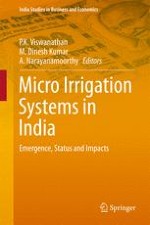2016 | OriginalPaper | Chapter
3. State of Adoption of Drip Irrigation for Crops Cultivation in Maharashtra
Author : A. Narayanamoorthy
Published in: Micro Irrigation Systems in India
Publisher: Springer Singapore
Activate our intelligent search to find suitable subject content or patents.
Select sections of text to find matching patents with Artificial Intelligence. powered by
Select sections of text to find additional relevant content using AI-assisted search. powered by
